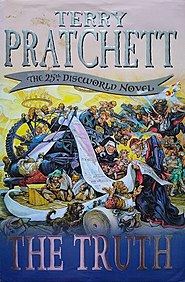
One thing I love about Terry Pratchett’s Discworld is how it realifies fantasy. Ankh-Morpork isn’t frozen in time like a miniature town in a snow globe; it’s a dynamic place that survives and adapts to the introduction of a gun and a postal service. The Truth fleshes out this city even further, introduces some unforgettable characters to the Discworld and tells a highly entertaining story.
The Truth begins when the dwarfs develop the printing press. They’re not sure how to use it most profitably, though, until they literally bump into William de Worde, who makes a modest living by writing about events in the city for a few people living abroad. William realizes that the dwarfs can print multiple copies of his news, and the dwarfs realize that these can be sold throughout the city. And thus the first newspaper is born.
Thie blessed event leads to excitement for all and problems for most. Lord Vetinari puts William in charge of the newspaper (thereby making him journalist, editor and human resources director combined) and the Watch find that they have to be careful around someone who is busily writing down whatever they say. The Guild of Engravers starts a competing tabloid, a vampire photographer offers his services and a bevy of citizens introduce William to advertising, Letters to the Editor and root vegetables shaped like body parts. Meanwhile two “facilitators” called Mr Pin and Mr Tulip are hired to deal with Vetinari…
To say anything more of the plot would be to give away spoilers, so I’ll just mention the people in this book. William is my favorite character from the Discworld. I usually don’t enjoy protagonists who are writers (unless the author is Stephen King), because this can come off as too much of a self-insert. But it was different to read about one who’s a journalist devoted to telling the truth and spelling everything correctly as he does so. It’s also rare to find sympathetic and realistic atheists in fiction, but this book is an exception.
He was all in favor of the countryside, provided that it was on the other side of a window.
A hero after my own heart.
The antagonists, Mr Pin and Mr Tulip, are superbly written too. Mr Pin is calculating and vicious and richly deserves his fate, while Mr Tulip is crude but equally vicious - except towards antique works of art, on which he is an authority. I like the kind of brawny muscleman who has an unexpected refined streak, and in Mr Tulip’s case, that serves as a great contrast to his swearing and his habit of sniffing any chemicals he can find (baking soda, epsom salts, etc). There’s even a Pulp Fiction reference involving these two.
The Truth is my second favorite Discworld novel (the first being Feet of Clay). I can’t recommend it highly enough.






6 comments:
Will try to find it! Do you need to read "Feet of Clay" first in order to follow it?
One of these days I'm going to sit down with the whole series and read, read, read!
Hi Marge,
No, you don't need to read "Feet of Clay" first, but I recommend that book as well. Especially if you enjoy mysteries. The answer is right there on the first page, too...
Hi Angela,
The Discworld series actually starts out kind of slow - the first couple of books were humorous fantasy without any deeper meaning or realism.
But then Pratchett hit his stride with Ankh-Morpork, the City Watch and the witches. Any books featuring one or more of those are likely to be winners. Ditto for Small Gods.
I love Pratchett. This is one that I haven't read yet. Thanks for the review.
For anyone knew to Discworld, I think, "Witches Abroad" is a great one to start with.
p.s. hmmm. I'm tired. I meant to say, anyone "new" to Discworld. Not "knew"
Post a Comment